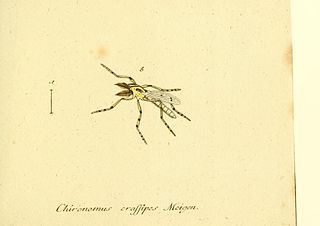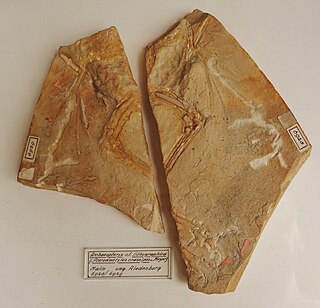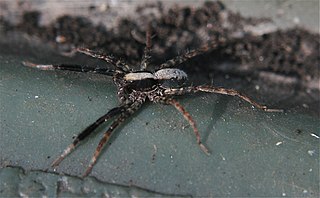
Selenocosmia crassipes, synonym Phlogius crassipes, also known as the "Queensland whistling tarantula" is a species of tarantula native to the east coast of Queensland, Australia. The name "whistling tarantula" comes from its ability to produce a hissing noise when provoked, a trait it shares with other Australian theraphosids. This hissing is produced by the spider stridulating a patch of setae associated with its chelicerae. It has also been called the "eastern tarantula". The species name crassipes is Latin for "fat leg" referring to the relatively fat front legs.
Amaranthus crassipes, also known as spreading amaranth, is a glabrous annual plant that is both native and introduced in the United States. In the U.S., it is found in New Mexico, Arizona, Texas, Alabama, South Carolina, and Louisiana. It is also found in Mexico, the West Indies, and South America.

Pontederia crassipes, commonly known as common water hyacinth, is an aquatic plant native to the Amazon basin, and is often a highly problematic invasive species outside its native range. It is the sole species of Pontederia subg. Oshunae.

Meleagridinae is a North American subfamily of birds in the family Phasianidae. It includes turkeys and their extinct relatives.
Conraua crassipes is a species of frog in the family Conrauidae. It is found in eastern Nigeria, Cameroon, Equatorial Guinea, Gabon, the Republic of the Congo, and the Democratic Republic of the Congo. Presumably it also occurs in the southwestern Central African Republic and in the Cabinda Enclave of Angola. Common name Abo slippery frog has been coined for it.

The striped shore crab, also known as the lined shore crab, is a small crab found on both rocky and hard-mud soft seashores of the northeastern and northwestern Pacific Ocean. In North America, this species occurs from central Oregon, south through California to near Ensenada, Baja California, Mexico. There is an isolated population with a wide range disjunction at Bamfield on Vancouver Island, Canada. The western Pacific population, including both Korea and Japan is isolated with a divergence time from the eastern Pacific population estimated between 0.8 and 1.2 Mya.

Eurycnemus is a genus of European non-biting midges in the subfamily Orthocladiinae of the bloodworm family (Chironomidae).
Hysterocrates crassipes is a species of spiders in the family Theraphosidae (tarantulas) found in Cameroon, Africa.
Ranunculus crassipes is a small flowering plant in the buttercup or crowfoot family Ranunculaceae that is native to the subantarctic region. The specific epithet comes from the Latin and refers to the plant's thicker and more succulent form compared to the closely related R. biternatus.
Cryptantha crassipes is a rare species of flowering plant in the borage family known by the common name Terlingua Creek cat's-eye. It is endemic to Brewster County, Texas, where it is known from only ten populations totaling about 5000 plants. All of the occurrences are within a ten-kilometer radius. This is a federally listed endangered species.

Morchella semilibera, commonly called the half-free morel, is an edible species of fungus in the family Morchellaceae native to Europe and Asia.
Madhuca crassipes is a plant in the family Sapotaceae. The specific epithet crassipes means "thick foot or stalk", referring to the fruit stalk.

Paraleptuca crassipes or the thick-legged fiddler crab is a species of fiddler crab that lives in intertidal habitats distributed across the western Pacific Ocean.
Gomphus crassipes is a species of fungus in the genus Gomphus, family Gomphaceae. It is native to Spain and North Africa and possibly threatened by habitat loss.
Marengo crassipes, is a species of spider of the genus Marengo. It is native to India and Sri Lanka.

Dorcadion crassipes is a species of beetle in the family Cerambycidae. It was described Ballion by 1878.
Cornops aquaticum is a semiaquatic species of grasshopper native to the Neotropics, from southern Mexico south to central Argentina and Uruguay. It feeds and breeds exclusively on members of the aquatic plant family Pontederiaceae, especially water hyacinth, and is being investigated as a possible biological pest control agent for the water hyacinth in countries where that plant is invasive.

Ostromia is a genus of anchiornithid theropod dinosaur from the Late Jurassic Painten Formation of Germany. The genus contains a single species, O. crassipes, named by Christian Foth and Oliver Rauhut in 2017.
Metepeira crassipes is a species of orb weaver in the spider family Araneidae. It is found in the United States and Mexico.

Schizocosa crassipes is a species of wolf spider in the family Lycosidae. It is found in the United States.










